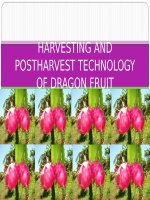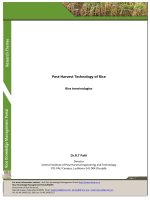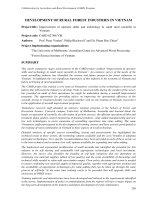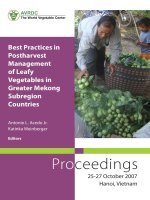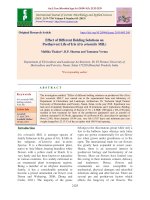post-harvest technology of rice terminologies
Bạn đang xem bản rút gọn của tài liệu. Xem và tải ngay bản đầy đủ của tài liệu tại đây (5.59 MB, 38 trang )
Page | 1
For more Information contact: Visit Rice Knowledge Management Portal
Rice Knowledge Management Portal (RKMP)
Directorate of Rice Research,
Rajendranagar, Hyderabad 500030. Email: , ,
Ph: 91-40-24591218, 295 Fax: 91-40-24591217
Post-Harvest Technology of Rice
Rice terminologies
Dr.R.T Patil
Director
Central Institute of Post Harvest Engineering and Technology
PO: PAU Campus, Ludhiana-141 004 (Punjab
)
Page | 2
For more Information contact: Visit Rice Knowledge Management Portal
Rice Knowledge Management Portal (RKMP)
Directorate of Rice Research,
Rajendranagar, Hyderabad 500030. Email: , ,
Ph: 91-40-24591218, 295 Fax: 91-40-24591217
Rough rice or paddy: Defined as rice in the husk after threshing.
Stalk paddy: Defined as unthreshed in the husk, harvested with part of the stalk.
Husked rice/brown rice: Rice from which the husk only has been removed retaining still the bran
layers and most of the germs. Such rice is sometimes reflected to as bran rice even though there
are variations having red or white bran coats.
Milled rice: Rice from which husk, germs, bran layers have been substantially removed by lower
machinery, also known as polished rice and if milled to high degree it is called as white rice.
Under milled rice: Rice from which the husk germs and bran layers have been partially removed
by power machinery and is also known as unpolished rice.
Hand produced rice: Rice from which the husk, germ and bran layers have been partially removed,
without the use of power machinery, also known as “home produced” or “hand milled rice”.
Parboiled rice: Rice, which has been specially processed by steaming or soaking in water, heating
usually by steam and drying. Parboiled paddy can be milled to various degrees or home produced
in the same way as ordinary paddy. It is called as parboiled milled or parboiled hand pounded.
Raw milled: The paddy, which is milled not after giving heat treatment, such as parboiling.
Coated rice: Defined as rice milled to a high degree and then coated with glucose on “Talcum”.
Whole grain: Refers to husked, milled or hand produced rice which does not contain any broken
grains smaller than 3/4 of the size of the whole kernel.
Broken rice: Husked, milled or hand produced rice consisting of broken grains of less than 3/4th
size of the whole grain but not less than 1/4th.
Fragmented rice: Small brokens upto 1/4th size of the whole grain.
Husk: The by-product from the milling of rice consisting of the outermost covering of the rice
kernels.
Bran: A by-product from the milling of rice consisting of the outer layer of the kernels with part of
germ.
Rice polishing: Now defined as the by-product from milling rice, consisting of the inner bran layer
of the kernel with part of the germ and a small percentage of the stoney interior also known as
rice meal or rice flour elsewhere.
Page | 3
For more Information contact: Visit Rice Knowledge Management Portal
Rice Knowledge Management Portal (RKMP)
Directorate of Rice Research,
Rajendranagar, Hyderabad 500030. Email: , ,
Ph: 91-40-24591218, 295 Fax: 91-40-24591217
Glutinous rice: A type of rice, which after cooking has a peculiar stickyness regardless of how it is
cooked.
Scented rice: A type of rice, which contains aroma and gives scented smell on cooking.
Rice flour: Ground polished rice which is mainly starch with very little gluten. Used in the same
way as corn flour and for noodles, sweets and short pastry.
Quick cooking rice: Rice that had been completely cooked then dehydrated.
Head rice yield: Head rice yield is the weight percentage of rough rice that remains as whole rice
(three-fourths kernel or greater) after complete milling.
Milling yield/Total yield: Milling yield is the weight percentage of rough rice that remains as
milled rice; i.e., the sum of head rice and "brokens."
Rice bran oil: It is the oil extracted from the germ and bran of rice.
Puffed rice: It is a type of puffed grain made from rice; usually made by heating rice kernels under
high pressure in the presence of steam, though the method of manufacture varies widely.
Popped rice: Raw rice is traditionally popped by heating rough rice at higher temperatures about
240°C for up to 45 seconds. The hull contributes to pressure retention before popping. aGood
popping varieties have a tight hull and a significant clearance between hull and brown rice and
when freshly harvested are free of grain fissures.
Rice flakes: The production of rice flakes begins with parboiling of rice which helps to soften the
grain and prepare it for processing. Once the rice is tender, the cooked grains are rolled and
flattened. After the mixture is the desired thickness, the flattened rice is allowed to dry
completely. The dried flakes are run through another rolling process to create simple flakes.
Page | 4
For more Information contact: Visit Rice Knowledge Management Portal
Rice Knowledge Management Portal (RKMP)
Directorate of Rice Research,
Rajendranagar, Hyderabad 500030. Email: , ,
Ph: 91-40-24591218, 295 Fax: 91-40-24591217
Introduction
Rice is the staple food for 65% of the population in India. It is the largest consumed calorie
source among the food grains. With a per capita availability of 73.8 kg it meets 31% of the total
calorie requirement of the population. India is the second largest producer of rice in the world
next to China. In India paddy occupies the first place both in area and production. Indian Basmati
Rice has been a favorite among international rice buyers. Following liberalization of international
trade after World Trade Agreement, Indian rice will become highly competitive and has been
identified as one of the major commodities for export. This provides us with ample opportunity for
development of rice based value-added products for earning more foreign exchange. Apart from
rice milling, processing of rice bran for oil extraction is also an important agro processing activity
for value addition, income and employment generation.
It has been reported that about 9 percent of paddy is lost due to use of old and outdated
methods of drying and milling, improper and unscientific methods of storage, transport and
handling. It has been estimated that total post harvest losses of paddy at producers’ level was
about 2.71 percent of total production. To minimise post harvest losses, precautions should be
taken to follow proper post harvest practises. They include timely harvest at optimum moisture
percentage (20 percent to 22 percent), use of proper method of harvesting; avoid excessive
drying, fast drying and rewetting of grains. Ensure drying of wet grain after harvest, preferably
within 24 hours to avoid heat accumulation, uniform drying to avoid hot and wet spots and
mechanical damage due to handling. The losses in threshing and winnowing can be avoided using
better mechanical methods. Proper sanitation during drying, milling and after milling to avoid
contamination of grains and protect from insects, rodents and birds and use of proper technique
of processing i.e. cleaning, parboiling and milling helps in reduction in post harvest losses. To avoid
storage losses maintaining optimum moisture content i.e. 12 percent for longer period and 14
percent for shorter storage period is essential.
Harvesting at proper maturity
Paddy crop should be harvested, when the grains become hard and contain about 20-22
percent moisture. Harvesting before maturity means a low milling recovery and also a higher
Page | 5
For more Information contact: Visit Rice Knowledge Management Portal
Rice Knowledge Management Portal (RKMP)
Directorate of Rice Research,
Rajendranagar, Hyderabad 500030. Email: , ,
Ph: 91-40-24591218, 295 Fax: 91-40-24591217
proportion of immature seeds, high percentage of broken rice, poor grain quality and more
chances of disease attack during storage of grain. Delay in harvesting results in grain shattering
and cracking of rice in the husk and expose the crop to insects, rodents, birds and pests attack, as
well as lodging. Harvesting during wet weather conditions should be avoided and done by
adopting proper method. The water from paddy field should be drained about a week or 10 days
before the expected harvesting, which helps in employing mechanical harvesters. Avoid pest
infestation prior to harvesting. Harvested material should be protected from rain and excessive
dew by covering, avoid direct sun drying, which leads to an increase in breakage of the grains
during milling. For combine harvesting, moisture percentage should be 18 per cent, or lower.
When paddy is harvested by hand it gets a chance to get dried before threshing. In the case of
combine harvesting, a sizeable percentage of green kernels are threshed along with mature
kernels. It paddy is harvested with a combine harvester and kept in gunny bags, rotting of seed will
invariably start. Therefore, it is very necessary that the paddy harvested with combine harvesters
must be dried until moisture percentage comes down to 13 per cent, or lower. Similarly, the
paddy harvested by hand should also be dried to 13 per cent or below moisture content. At the
time of storing the moisture in the seed grain should never exceed 13 per cent and there should
be no green kernels. Use tarpaulin or pukka (cemented) floor for drying
Threshing of Paddy
Align all the panicles in one line to get proper threshing. If the threshing is delayed, keep
the harvested paddy stalk bundles in a dry and shady place, which facilitates the air circulation and
prevents excessive heating. Thresh the paddy in the field itself. Transport the grain in bags, which
minimises the grain losses. Avoid too much post harvest handling of paddy to minimise the grain
losses. Pack the paddy in sound B-Twill jute bags totally free from any contamination.
Simple pedal operated threshers are also used to thresh the paddy in the field. One person
operates the thresher with foot pedal and one or two persons feed the bales from behind for
threshing. These threshers are also motorised with Single phase 1HP electric motor for threshing
of Paddy. The machine is run and one or two persons feed the bales from behind for threshing.
Page | 6
For more Information contact: Visit Rice Knowledge Management Portal
Rice Knowledge Management Portal (RKMP)
Directorate of Rice Research,
Rajendranagar, Hyderabad 500030. Email: , ,
Ph: 91-40-24591218, 295 Fax: 91-40-24591217
Mechanical Paddy threshers consist of worm type threshing cylinder, oscillating box,
winnowing and cleaning attachment, feeding chute etc. These threshers can be operated both
with motor and diesel engine tractors. During threshing the paddy crop's straw is separated from
grain by worm type cylinder. The straw is thrown out from the machine with the help of blower.
Other impurities like dust/dirt are thrown out through other outlet. Extra blowers provided
cleaning the grains of left-over impurities. The capacity of these machines varies from 300 kg/h to
1500 kg/h.
Cleaning of Paddy
The hand operated and power operated winnowing fans are commercially available. The
paddy threshed by manual beating or by pedal operated paddy thresher is cleaned by using these
fans. These winnowing fans consist of frame either made up of wood, angle iron, welded steel or
combination of the two along with driving mechanisms namely, sprocket and chain, belt and
pulleys and single or double reduction gears.
A hand operated paddy winnower was developed by Central Rice Research Institute,
Cuttack. Two women workers are required for the operation of this winnower, one for cranking
the blower and other for feeding the threshed material and collection of grain. The average output
was found to be 242 kg grain/h and winnowing efficiency was found to be 88.36%. The equipment
developed was found to be suitable for operation by women workers as the heart rate, work pulse
value and energy expenditure rate are within the acceptable limits.
Motorised paddy winnowing machine was developed at TNAU Coimbtore. It consists of a
feed hopper to hold the grain for cleaning. It discharges the grain over a scalper and removes
bigger size impurities. A blower provided at the bottom, passes air against the grain falling
through the scalper which separates the straw, chaff and other impurities. The dust, chaff and
straw are collected separately and cleaned paddy is taken out through another outlet near the
bottom of the unit. The capacity of the machine is 500-750 kg/h and operated with 1 hp motor.
The cost of machine is Rs. 20,000 and cost of cleaning comes to Rs 5/100 kg.
Page | 7
For more Information contact: Visit Rice Knowledge Management Portal
Rice Knowledge Management Portal (RKMP)
Directorate of Rice Research,
Rajendranagar, Hyderabad 500030. Email: , ,
Ph: 91-40-24591218, 295 Fax: 91-40-24591217
Milling of Paddy
Rice milling is the oldest and the largest agro processing industry of the country. At present
it has a turn over of more than 25,500/- crore per annum. It processes about 85 million tonnes of
paddy per year and provides staple food grain and other valuable products required by over 60%
of the population. Paddy grain is milled either in raw condition or after par-boiling, mostly by
single hullers of which over 82,000 are registered in the country. Apart from it there are also a
large number of unregistered single hulling units in the country. A good number (60 %) of these
are also linked with par-boiling units and sun -drying yards. Most of the tiny hullers of about 250-
300 kg/hr capacities are employed for custom milling of paddy. Apart from it double hulling units
number over 2,600 units, under runner disc shellers cum cone polishers numbering 5,000 units
and rubber roll shellers cum friction polishers numbering over 10,000 units are also present in the
country. Further over the years there has been a steady growth of modern rice mills in the
country.
Basic Milling machines
Traditional huller
It is a relatively small unit with a throughout capacity of 100 to 150 kg per hour operated
by oil or steam engine or an electric motor. In small villages single hullers are used while in bigger
mills of 1 to 2 tonnes per hour capacity batteries of 3 to 4 hullers are used. Most of the other
operations, excepting milling proper, are done invariably. The huller does the job of the husk
removal and bran removal simultaneously. The working element of this machine is made of cast
iron, which bears very heavily on rice grains thereby breaking them to pieces which are liable to be
lost alongwith husk. The hullers even though cheaper in cost are wastage and have high labour
requirement.
Centrifugal shellers
In this machine the grains are subjected to centrifugal force by means of a rotating
impeller. Significant characteristics of these centrifugal shellers are: Their high capacity and simple
constitutional features as there is only one moving part i.e. an impeller. Its casing is lined with
Page | 8
For more Information contact: Visit Rice Knowledge Management Portal
Rice Knowledge Management Portal (RKMP)
Directorate of Rice Research,
Rajendranagar, Hyderabad 500030. Email: , ,
Ph: 91-40-24591218, 295 Fax: 91-40-24591217
rubber. The paddy is fed to the centre of the rotor from where it is thrown towards the casing
with great force where it is shelled. This machine has a very good potential, as there is a possibility
of combining several units and obtain a compact multistage mill to affect complete shelling.
Another advantage, in case of this type of machine is that heating of grains does not take place as
there is no grinding action involved. Polishing of brown rice obtained is done by a separate
polisher. The centrifugal shellers are available which have the built-in winnower to remove the
husk.
Disc sheller
In this type the two operations of dehusking and whitening were intended to be carried
out separately in separate machines. The disc sheller mills may be called unit mills as all the
operations involved in milling, cleaning, dehusking paddy separation, polishing and grinding are
done mechanically and by separate machines. The basic machine i.e. under runner disc sheller
consists of two discs with their inner faces lined with emery bottom one rotating and the other
stationary. The paddy passes in between the two discs and gets shelled or dehusked. Therefore
the breaking is less and the white rice yield is also more of the order of 66-68 percent with 10 to
15 percent brokens. There are adjustments provided on the dehusker so that the clearance
between the discs could be adjusted for most of the variety of paddy. It gives a marked increase (2
to 4 percent) in rice output over conventional huller in almost all milling condition.
Rubber Roll Sheller
The greatest advantage of rubber roller over cast iron cylinder or the emery roller is that
due to their compressible nature the grain handled gently during the process of dehulling. The
functional coefficient between paddy grain surface and rubber is lower than that of paddy and
steel. This facilities easy dehulling. The two rubber rollers rotate in opposite direction at
differential speed to take off the aspiration. Since all the paddy is not dehusked paddy must be
separated. This is accomplished by a paddy separator. The brown rice (rice with bran coating on) is
then fed to rice whitener where the bran is removed.The rubber roller mill gives better quality rice
and bran which fetch more price in the market.
Page | 9
For more Information contact: Visit Rice Knowledge Management Portal
Rice Knowledge Management Portal (RKMP)
Directorate of Rice Research,
Rajendranagar, Hyderabad 500030. Email: , ,
Ph: 91-40-24591218, 295 Fax: 91-40-24591217
Composite Rice Mill
The basic rice milling processes consists of Pre Cleaning to remove all impurities and
unfilled grains from paddy, De-stoning for Separating small stones from paddy, Husking to
removing husk from paddy, Aspiration to separate the husk from brown rice/ unhusked paddy,
Paddy Separation which separates the unhusked paddy from brown rice, Whitening to removing
all or part of the bran layer and germ from brown rice, Polishing to improve the appearance of
milled rice by removing the remaining bran particles and by polishing the exterior of the milled
kernel, Length Grading to separate small and large brokens from head rice, Blending is for mixing
head rice with predetermined amount of brokens, as required by the customer.
The recovery of whole grains in a traditional rice mill using steel hullers for dehusking is
around 52-54%. There is excessive loss in the form of coarse and fine brokens. Further loss of large
portion of endosperm layers during the dehusking operation further accentuates the problem.
Against it, the recovery percent of whole grains in modern rice mills using rubber roll shellers for
dehusking operation is around 62-64%. The whole grain recovery percent further increases to 66-
68% in case of milling of parboiled paddy. Thus it can be seen that there is an overall improvement
of recovery of whole grains by about 10-14% if one uses rubber roll shellers for rice milling
operations. The recovery of various components from these improved rice mills are milled head
rice: 62-68%, rice bran: 4-5%, rice husk: 25%, and germ wastages: 2%-8%
It has been observed that dehusking using rubber roll shellers reduces the risk of breaking the
grain because husk is pulled off almost at once and pressure is applied by means of resilient
surfaces across the width of the grain, where kernels, generally are much more uniform than they
are by length. Moreover, the process does not remove the internal epidermis of the husk. Thus
the deshelled grains with their silver skin envelope are protected against scratches and keep
longer and better while the silver skin and the germ increases the quantity of bran which is
produced while whitening. The improved rice mills have a better husk and rice bran aspiration
system. The same prevents mixing of fine brokens with rice bran. Therefore the quality of rice
bran obtained is better.
Generally 2.00 to 2.50 acre of land is required for establishing an improved rice milling unit
having an installed processing capacity of 2 MT/ hr; operating for single shift / day of 8 hr
Page | 10
For more Information contact: Visit Rice Knowledge Management Portal
Rice Knowledge Management Portal (RKMP)
Directorate of Rice Research,
Rajendranagar, Hyderabad 500030. Email: , ,
Ph: 91-40-24591218, 295 Fax: 91-40-24591217
duration; 300 days per annum; i.e. 4800 MT /annum. The land should be with proper elevation.
Low lying areas should be avoided. Else proper land filling, compaction and consolidation should
be done. Drainage and linkages with road and other communication should also be ensured. The
layout of the rice milling plant should be done in a manner that helps in smooth operation of
various unit operations in tandem to bring about optimal capacity utilization and economizing
power consumption. The tentative cost of land and land development charges for the model
project has been considered at Rs. 5.00 Lakh ( Rs. 3.75 Lakh being the cost of the land @ Rs. 1.50
Lakh per acre for 2.50 acre and the remaining Rs. 1.25 Lakh being the cost for site development
such as construction of boundary wall, internal roads and drainage system etc.) The various
construction requirement of an improved rice milling unit are 1. Raw paddy godown 2. Cleaning
unit 3. Drier and necessary supporting structures such as, boiler /blower system etc., 4. Milling
section, 5. Finished product stores, 6. Machine rooms, 7. Auxiliary structures such as office watch
and ward etc.
1. Raw paddy godown- RCC framed superstructure with 10'' thick brick walls, IPS flooring with
damp proof treatment with 1.62 kg DPC /sq.m of floor area and base of the side walls, roofing
consisting of ACC sheets affixed with J hooks, bolts and other accessories to steel truss made of
MS angle of desired section 80' x 35'
2. Cleaning Shed - Similar to the raw paddy godown 25' x 32'
3. Milling shed -RCC framed superstructure with brick walls, IPS flooring and roofing consisting of
ACC sheets affixed with J Hooks and nuts to steel trusses made of MS angle of desired section and
strength bearing capacity. 80' x 35'
4. Finished product or Milled rice storage shed 30' x 35'
5. Machine shed - with masonry structure with ACC sheet roofing on lean truss 40' x25'
6. Auxiliary structures; a Office unit 10' x 15' , Labor quarters 30 ' x 15', Machine Room for auxiliary
machines like blowers/ generator set etc. 40' x 15', Bore well and water connections, e Sanitary
and plumbing
Page | 11
For more Information contact: Visit Rice Knowledge Management Portal
Rice Knowledge Management Portal (RKMP)
Directorate of Rice Research,
Rajendranagar, Hyderabad 500030. Email: , ,
Ph: 91-40-24591218, 295 Fax: 91-40-24591217
Parboiling of Paddy
Parboiling of paddy is a hydrothermal process in which the starch granules within the rice
grain are gelatinized by the application of steam and hot water. This helps in higher percentage of
recovery of head rice. Parboiling rice drives nutrients, especially thiamine, from the bran into the
grain, so that parboiled white rice is 80% nutritionally similar to brown rice. It reduces breakage in
milling, improves storage life and helps in the preservation of protein and vitamins in the rice. The
starches in parboiled rice become gelatinized, making it harder and glassier than other rice. In
conventional methods, parboiling is carried out by hot water soaking and subsequent steaming.
Under the prevailing global energy crisis, any parboiling method which saves energy is a welcome
feature. Energy can be saved in the parboiling process by skipping any one of the three distinct
unit operations namely, soaking, steaming and drying or by combining any two operations at a
time. Direct steaming of freshly harvested high moisture paddy improves the head rice recovery
but with inferior quality. Parboiling of the soaked paddy could be carried out with less energy
input by applying the dry heat instead of moist heat (steam) which takes care of both
gelatinization and subsequent drying. One of the possible methods for energy saving for parboiling
of paddy is the continuous dry-heat parboiling. The dry-heat parboiling has the unique feature of
parboiling and drying of paddy, simultaneously. The heat requirement for parboiling of paddy is
the same irrespective of method employed to achieve it, however the efficiency of the system is
governed by thermal efficiency of the heating source, heat transfer between source and the
subject, heat loss by conduction, convection and radiation, and sensible heat of the system.
Drying of parboiled paddy
Sundrying of parboiled paddy
Most of paddy parboiled in the traditional mills is sun dried on a drying floor. The drying
floor is normally cemented floor consisting of layer of brick bats with cement plaster on it. The
parboiled paddy is spread on the floor 10 to 30 mm thick layer by labour with the help of a plank
then it is continuously stirred by a spiked plank or by feet. After four hours of drying in sun, paddy
is heaped and covered by mats for tempering for a period of 2 to 3 hours. Then the paddy is
spread again for 2 hours in the sun to dry it to desirable moisture content. Therefore, drying of
Page | 12
For more Information contact: Visit Rice Knowledge Management Portal
Rice Knowledge Management Portal (RKMP)
Directorate of Rice Research,
Rajendranagar, Hyderabad 500030. Email: , ,
Ph: 91-40-24591218, 295 Fax: 91-40-24591217
parboiled paddy from 30 percent to 13 percent moisture content takes about 6 hours during
summer and relatively long period about 8 to 10 hours during winter.
Mechanical drying of paddy
It is the process utilising mechanical means for drying grain by ventilating natural air or
heated air through the grains mass to accomplish removal of moisture from it. In other words
mechanical drying of paddy refers to removal of moisture from wet paddy by unheated and/or
heated forced air at a predetermined rate of flow, air temperature and air relative humidity. Rate
of moisture removal could be regulated. It is observed that if paddy is harvested at about 24
percent moisture and dried mechanically in stages by 3 or 4 passes of heated air the milling losses
are minimum. Heated air convection type dryers are commonly used for drying paddy. Types of
commonly used dryers are Bag dryers, Bin or batch dryers, Continuous flow dryers and Rotary
drum dryers
Bag Dryers:
This type of dryer is suitable for drying smaller quantity of grains. It requires large number
of unskilled labour for handling the bags. The dryer consists of a large floor area in the building
with the opening over which the grain bags are placed. The openings are covered with a
perforated material to support the bags and allow air movement through the bags. The air is
blown in the holes by a burner and air blower assembly. In this type dryer, air is heated up to 45°C
and is blown in the dryer at the rate of 4 cubic meters per minute per bag of 45 kg of dried grains.
The bag should be turned once during operation for exposing both sides to heated air.
Batch Dryer:
The dryer consists of a bin or a container to hold grain with an air blower and a burner for
providing hot air. The bin or the container is fitted with a perforated bottom in case of most of the
bin or batch dryers. However godown or a room in a building with a perforated floor may also be
used. The godown or room is equipped with air dust system for air distribution throughout the
room. A fan with heater unit is then connected to the duct system to supply the required air to dry
the grains. In all batch type dryers the depth of grain is limited due to high power requirement to
force air through deeper grain mass.
Page | 13
For more Information contact: Visit Rice Knowledge Management Portal
Rice Knowledge Management Portal (RKMP)
Directorate of Rice Research,
Rajendranagar, Hyderabad 500030. Email: , ,
Ph: 91-40-24591218, 295 Fax: 91-40-24591217
Continuous flow dryers:
Continuous flow dryers are of two types (I) mixing and (ii) non-mixing type. Both types of
dryers are used for commercial drying of paddy and hence high drying capacities. Grain is usually
fed in the top and flows through the dryer by gravity. Rate of discharge is mechanically regulated
at the bottom. Drying is accomplished by forcing heated air through the grain as it flows
downwards. In non-mixing columnar dryer the paddy descends between two parallel screens set
15 to 20 cms apart while heated air is blown through the screens. No appreciable mixing occurs
and effect is similar to drying in static bed with a depth equal to distance between the screens.
Mixing type are of many designs, two of the most popular being baffle design and Louisiana State
University design. In a baffle dryer paddy flows downward in zig-zag path through the baffles while
heated air is forced through the grains. The Louisiana State University dryer consists of a bin in
which layers of inverted shape air channels are installed. Alternating layers are air inlet and air
exhaust channels. Each layer is offset so that the top of each inverted channel split in the stream
of paddy coming on it. Paddy flows between channels taking a zig-zag path as it descends. Drying
air passes from air inlet the air exhaust channels thus removing moisture from the paddy.
Rotating Drum dryer:
This consists of a large drum 1 to 2 meter in diameter and 3 to 6 meters in length placed on
a slight inclination and the drum rotates about its axis. The inside of the drum is equipped with the
helical straight edge ribs to provide the mixing and the forward movement of the paddy during
drying operation. The hot air blown at the lower end of the drum and the paddy flows counter
current to direction of air flow. These types of dryers are normally used for drying parboiled
paddy.
Modern Paddy Dryers
The new developed mechanical dryers reduced the moisture of parboiled paddy from 36%-
12% in a continuous operation within a few minutes. This offers several advantages over the
conventional dryer in terms of lower utility consumption, reduction in breakage, no color
variation, single pass drying, increase in equipment life and minimal maintenance. It is supplied
with steam heater, hot air blower and exhaust fan with dust collection system. The continuous
steaming and drying system consists of Continuous steaming vessel with feed and discharge
Page | 14
For more Information contact: Visit Rice Knowledge Management Portal
Rice Knowledge Management Portal (RKMP)
Directorate of Rice Research,
Rajendranagar, Hyderabad 500030. Email: , ,
Ph: 91-40-24591218, 295 Fax: 91-40-24591217
control, Pre-Dryer (Static Fluid Bed) and Vibrating Fluid Bed Dryer. The cleaned and steamed
paddy is soaked in the soaking tank at required temperatures for a desired duration. After removal
of water from the soaking tank, the soaked paddy is passed through continuous steaming vessel
for proper gelatinization to ensure minimum breakage of grain. The steaming vessel is provided
with controlled feed and discharge mechanism to optimize gelatinization. This steamed paddy at
36% inlet moisture is continuously fed into a Static Fluid Bed Dryer at a uniform feed rate where
the surface moisture is instantly removed. There after the paddy at 32% moisture is fed into first
vibrating fluid bed dryer, where the paddy is kept in suspended stage and the moisture is reduced
to 22%. This paddy at 22% moisture is fed into second fluid bed dryer where the moisture is
reduced to 16% and is then fed into third fluid bed dryer where the moisture is further reduced to
12-14%. However, in case of Basmati Rice, the moisture is reduced to 22% using the static and
first Vibro Fluid Bed Dryer and further drying is carried out in LSU dryer upto 12%.
Mini Parboiling Unit
Improved parboiling technique of hot water soaking and atmospheric steaming (CFTRI) and
pressure parboiling (RPEC) has been developed. The Cuttack centre has developed a mini
parboiling unit for on farm/domestic parboiling of paddy. Traditionally soaking and steaming are
done separately with parboiling unit. Both the operations can be done without any further
handling in the same unit. A hot soaking for 3-5 hours in 75°C water and steaming and subsequent
sun drying results in about 2 percent more head rice than achieved traditionally. The capacity is 75
kg per batch with output of 150 kg per day.
Toxins in Rice
Aflatoxin: -Aflatoxins are the type of mycotoxins, which are derived from the fungi, which
affect human health. Aflatoxins are produced by Aspergillus flavus, Aspergillus ochraceus and
Aspergillus parasiticus. Contamination of Aflatoxins occurs at any stage from field to storage,
whenever environmental conditions are conducive for fungi. The fungie are generally regarded as
storage fungi, which grow under conditions of relatively high moisture/humidity. It causes severe
liver damage and both liver and intestinal cancer in humans. Generally, milled rice contains low
Page | 15
For more Information contact: Visit Rice Knowledge Management Portal
Rice Knowledge Management Portal (RKMP)
Directorate of Rice Research,
Rajendranagar, Hyderabad 500030. Email: , ,
Ph: 91-40-24591218, 295 Fax: 91-40-24591217
levels of Aflatoxins, but parboiled rice and paddy harvested in rainy season contains high Aflatoxin
levels. Storage insects like rice weevil, lesser grain borer, khapra beetle, etc also encourage
Aflatoxins in paddy/rice. According to PFA Rules, 1955, the Aflatoxins in rice should not be more
than 30 microgram / kilogram.
Prevention and Control of Aflatoxins: The paddy/rice should the stored at safe moisture level.
Prevent the growth of fungi by drying of grains. Use proper and scientific storage method. Prevent
insect infestation by adopting chemical treatment to avoid fungus contamination. Separate the
infected grains.
Packaging
Good packaging provides not only convenient handling in transportation and storage but
also attracts consumers to pay more. Packaging is essential to avoid spoilage and to prolong the
quality. Packaging of paddy/rice is also important for long-term storage to fulfil the demand of old
rice in the market, particularly in case of Basmati and non-parboiled rice. Paddy/rice, if kept in
open, quality may be adversely affected. Packaging is closely related to labelling and branding. In
present scenario, branding and labelling of rice has significant impact on consumer preference.
More care is required in packaging of rice meant for export. This is because of demonstrative
effect and the requirements of consumers in different countries; exporters have now started using
transparent, colourful and attractive packaging. For good packaging, the packages must protect
rice very well and should be long lasting, look clean, convenient to handle and carry out from the
store easily.
The graded rice should be packed in new, clean, sound and dry jute bags, cloth bags,
polywoven bags, polyethylene, polypropylene, high molecular high density polyethylene paper
packages or in other food grade plastic/packaging materials. The packages shall be free from
insect infestation, fungus contamination, deleterious substances and undesirable or obnoxious
smell. Each package shall be securely closed and suitably sealed. The rice shall be packed in
quantities as specified under the provisions of the Standards of Weights and Measures (Packaged
Commodities) Rules, 1977 as amended from time to time. Suitable number of consumer packs
